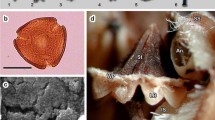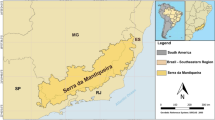Abstract
The aim of this study is to determine the conservation status of Scrophularia valdesii Ortega-Olivencia & Devesa, a threatened narrow endemism of the Duero Basin (central-western Spain and north-eastern Portugal, Lusitan Duriensean biogeographical sector), by using the IUCN (2001) IUCN Red List Categories and Criteria: version 3.1. IUCN Species Survival Commision. IUCN, Gland, Switzerland and Cambridge, UK. The species is listed as threatened in several Spanish compilatory works on threatened flora, such as `The Spanish Red List of Vascular Flora' and the `Atlas and Red Book of Threatened Vascular Flora of Spain', although it does not figure as such in any Portuguese document. Here we report detailed studies of its distribution, and assess its current conservation status with respect to this, the sizes of its populations, and the threats it faces. Our estimation of the size of the Iberian populations was based on our own census data from those sites at which we found the species. All censuses were performed by direct counting of all potentially reproductive individuals. Fourteen populations were found, and the total members thought to exist are 161, with a highly fragmented distribution on the Spanish–Portuguese border along the valley of the River Duero. Exhaustive bibliographical and field surveys were carried out and herbarium specimens housed in several herbaria were revised in order to determine the Extent of Occurrence and the Area of Occupancy. Based on our data, the species is classifiable as Critically Endangered and Endangered in Portugal and Spain, respectively. The risk of local population extinction is high due to its typically small local population sizes and suitable conservation strategies should be developed in order to preserve the species.
Similar content being viewed by others
References
Allee W.C., Emersen A.E., Park O., Park T. and Schmidt K.P. (1949). Principles of Animal Ecology. Saunders, Philadelphia, 837
Amich F. (1980). Datos acerca de la flora salmantina. Anales del Jardín Botánico de Madrid 36: 291–300
Amich F., Bernardos S., Aguiar C., Fernández-Diez J. and Crespí A. (2004). Taxonomic composition and ecological characteristics of the endemic flora of the lower Duero Basin (Iberian Peninsula). Acta Botanica Gallica 151: 341–352
Anonymous (2001). Decreto 164/2001, de 7 de Juniopor el que se aprueba el Plan de Ordenación de los Recursos Naturales del Espacio Natural Arribes del Duero (Salamanca-Zamora). Boletín Oficial de la Junta de Castilla y León 114: 9129–9156
Ballester-Hernández S., Rosselló-Graell A., Draper D. and Correia A.I. (2003). Size structure in populations of three woody species from Alentejo (Portugal). Bocconea 16: 919–924
Bernardos S., Amado A., Aguiar C., Crespí A.L., Castro A. and Amich F. (2004a). Aportaciones al conocimiento de la flora y vegetación del centro-occidente ibérico (CW de España y NE de Portugal). Acta Botanica Malacitana 29: 285–295
Bernardos S., Crespí A., Aguiar C., Fernández J. and Amich F. (2004b). The plant communities of the Rumici indurati–Dianthion lusitani alliance in the Lusitan Duriensean biogeographical sector (NE Portugal and CW Spain). Acta Botanica Gallica 151: 147–164
Bizoux J.P., Brevers F., Meerts P., Graitson E. and Mahy G. (2004). Ecology and conservation of Belgian populations of Viola calaminariaa metallophyte with a restricted geographic distribution. Belg. J. Bot. 137: 91–104
Blanca G. and Marrero M. (2003). Las categorias de la UICN: algunas reflexiones y comentarios. In: Bañares, A., Blanca, G., Güemes, J., Moreno, J.L. and Ortiz, S. (eds) Atlas y Libro Rojo de la Flora Vascular Amenazada de España, pp 41–45. Dirección General de Conservación de la Naturaleza, Madrid
Brown J.S. (1994). Restoration ecology: living with the Prime Directive. In: Bowles, M.L. and Whelan, C.J. (eds) Restoration of Endangered Species. Planning and Implementation, pp 355–380. Cambridge University Press, Cambridge, Conceptual Issues
Castroviejo S. (eds). (1986). Flora Ibericavols. 1–8, 10 and 14. Consejo Superior de Investigaciones Científicas, Madrid
Christ C., Hillel D., Matus S. and Sweeting J. (2003). Tourism and Biodiversity: Mapping Tourisms Global Footprint. Conservation International, Washington/ Durban
Cody M.L. (1986). Diversity, rarity and conservation in Mediterranean-climate regions. In: Soule, M.E. (eds) Conservation Biology, The Science of Scarcity and Diversity, pp 122–152. Sinauer Associates Inc., Sunderland, Massachusetts
Costa M. (2004). Biogeografía. In: Izco, J., Barreno, E., Brugués, M., Costa, M., Devesa, J.A. and Fernández-González, F. (eds) Botánica, pp 795–852. MacGraw Hill Interamericana, Madrid
Cox G.W. (1993). The ecology of extinction. In: Cox, G.W. (eds) Conservation Ecology, pp 13–22. W.C. Brown Publishers, Dubuque, Iowa
Norton D.A. and Langhe P.J. (2004). The ecology and conservation of Kunzea sinclairii (Myrtaceae), a naturally rare plant of rhyolitic rock ourcrops. Biol. Conserv. 117: 49–59
Dinsdale J., Dale P. and Kent M. (1997). The biogeography and historical ecology of Lobelia urens L. (the Heath Lobelia) in southern England. J. Biogeogr. 24: 153–175
Domínguez Lozano F., Moreno Saiz J.C. and Sainz Ollero H. (2003). Rariry and threat relationships in the conservation planning of the Iberian flora. Biodivers. Conserv. 12: 1861–1882
Falk D.A., Millar C.I. and Olwell M. (1996). Restoring Diversity: Strategies for Reintroduction of Endangered Species. Island Press, Washington, DC, 505
Fiedler P.L. and Ahouse J.J. (1992). Hierarchies of cause toward an understanding of rarity in vascular plant species. In: Fiedler, P.L. and Jain, S.D. (eds) Conservation Biology: The Theory and Practice of Nature Conservation, Preservation and Management, pp 23–48. Routledge, Chapman and Hall Inc., New York
García M.B., Guzmán D. and Goñi D. (2001). An evaluation of the status of five threatened plant species in the Pyrenees. Biol. Conserv. 103: 151–161
Given D.R. (1994). Principles and Practice of Plant Conservation. Timber Press, Portland, Oregon, 292
González-Talaván A., Santos M., Bernardos S., Bariego P. and Amich F. (2003). Bañares, A., Blanca, G., Güemes, J., Moreno, J.L., and Ortiz, S. (eds) Atlas y Libro Rojo de la Flora Vascular Amenazada de España, pp 908. Dirección General de Conservación de la Naturaleza, Madrid
González-Talaván A., Santos M., Bernardos S., Bariego P. and Amich F. (2004). Bañares, A., Blanca, G., Güemes, J., Moreno, J.L., and Ortiz, S. (eds) Atlas y Libro Rojo de la Flora Vascular Amenazada de España2a ed, pp 910. Dirección General de Conservación de la Naturaleza, Madrid
Grizzle R.E. (1994). Environmentalism should include human ecological needs. Bioscience 44: 263–268
Hackney E.E. and MacGraw J.B. (2001). Experimental demonstration of an Allee effect in American ginseng. Conserv. Biol. 15: 129–136
IUCN (2001). IUCN Red List Categories and Criteria: version 3.1. IUCN Species Survival Commision. IUCN, Gland, Switzerland and Cambridge, UK
IUCN (2003). Guidelines for Application of IUCN Red List Criteria at Regional levels: version 3.0. IUCN Species Survival Commision. IUCN, Gland, Switzerland and Cambridge, UK
Kruckeberg A.R. and Rabinowitz D. (1985). Biological aspects of endemism in higher plants. Annu. Rev. Ecol. Syst. 16: 447–479
Lande R. (1988). Genetic and demography in biological conservation. Science 241: 1455–1460
Lande R. (1993). Risks of population extinction from demographic and environmental stochasticity and random catastrophes. Am. Nat. 142: 991–927
Lande R. (1998). Anthropogenic, ecological and genetic factors in extinction and conservation. Res. Popul. Ecol. 40: 259–269
Lovett Doust L. and Lovett Doust J. (1995). Wetland management and conservation of rare species. Can. J. Bot. 73: 1019–1028
Mace G.A. and Lande R. (1991). Assessing extinction threats: towards a reevaluation of IUCN threatened species categories. Conserv. Biol. 5: 148–157
Marcos N., Amado A. and Aguiar C. (2004). Scrophularia valdesii Ortega-Olivencia & Devesa – confirmada a presença en Portugal de mais um endemismo lusitano-duriense. De Novarum Flora Lusitana Comentarii – I. Nota 12 en Notas do Herbario da Estação Florestal Nacional (LISFA) Fasc. XVIII. Silva Lusitana 11: 233–234
Maunder M. (1992). Plant reintroduction: an overview. Biodivers. Conserv. 1: 51–61
Melendo M., Giménez E., Cano E., Gómez-Mercado F. and Valle F. (2003). The endemic flora in the south of the Iberian Peninsula: taxonomic composition, biological spectrumpollination, reproductive mode and dispersal. Flora 198: 260–276
Menges E.S. (1991). The application of minimum viable population theory to plants. In: Falk, D.A. and Holsinger, K.E. (eds) Genetics and Conservation of Rare Plants, pp 450–461. Oxford University Press, Oxford, New York
Menges E.S. (1992). Stochastic modeling of extinction in plant populations. In: Fiedler, P.L. and Jain, S.K. (eds) Conservation Biology: the Theory and Practice of Nature Conservation, Preservation and Management, pp 253–276. Chapman & Hall, New York
Mills M.H. and Schwartz M.W. (2005). Rare plants at the extremes of distribution: broadly and narrowly distributed rare species. Biodivers. Conserv. 14: 1401–1420
Moreno Saiz J.C., Dominguez Lozano F. and Sainz Ollero H. (2003). Recent progress in conservation of threatened Spanish vascular flora: a critical review. Biol. Conserv. 113: 419–431
Morse L.E. (1996). Plant rarity and endangerment in North America. In: Falk, D.A., Millar, C.I. and Olwell, M. (eds) Restoring Diversity: Strategies for Reintroduction of Endangered Species, pp 7–22. Island Press, Washington, DC
Olivieri I. and Vitalis R. (2001). La biologie des extinctions. Médecine Science 17: 63–69
Oostermeijer J.G.B., Luijten S.H. and Den Nijs J.C.M. (2003). Integrating demographic and genetic approaches in plant conservation. Biol. Conserv. 113: 389–398
Oostermeijer J.G.B., Luijten S.H., Petanidou P., Kos M., Ellis-Adam A.C. and Den Nijs J.C.M. (2000). Pollination in rare plants: is population size important?. Det Norske Videnskaps-akademi. I. Matematisk Naturvidenskapelige KlasseSkrifterNy Serie 39: 201–213
Ortega-Olivencia A. 1989. Estudio taxonómico del género Scrophularia L. en la Península Ibérica y Baleares. Unpublished PhD Thesis, Universidad de Extremadura, Badajoz.
Ortega-Olivencia A. and Devesa J.A. (1991a). Dos nuevos táxones del género Scrophularia: S. viciosi y S. valdesii Candollea 46: 111–118
Ortega-Olivencia A. and Devesa J.A. (1991b). Contribución al estudio cariológico del género Scrophularia L. (Scrophulariaceae) en la Península Ibérica e Islas Baleares. Lagascalia 16: 171–198
Ortega-Olivencia A. and Devesa J.A. (1993). Revisión del género Scrophularia (Scrophulariaceae) en la Península Ibérica e Islas Baleares. Ruizia 11: 5–157
Ortega-Olivencia A. and Rodríguez-Liaño T. (2002). Novedades corológicas del género Scrophularia en España. Acta Botanica Malacitana 27: 269
Primack R.B. (1998). Essentials of Conservation Biology. Sinauer, Sunderland, USA, 660
Rabinowitz D. (1981). Seven forms of rarity. In: Synge, H. (eds) The Biological Aspects of Rare Plant Conservation, pp 205–217. Wiley, New York, USA
Rebelo A.G. (1994). Interative selection procedures: centres of endemism and optimal placement of reserves. Strelitzia 1: 231–257
Ribera M.O. (1996). Guía para la categorización de Vertebrados Amenazados. Centro de Datos para la Conservación. La Paz, Bolivia, 80
Rivas-Martínez S., Díaz T.E., Fernández-González F., Izco J., Loidi J., Lousã M. and Penas A. (2002). Vascular plant communities of Spain and Portugal. Itinera Geobotanica 15: 5–922
Rivas-Martínez S., Fernández-González F., Loidi J., Lousã M. and Penas A. (2001). Syntaxonomical checklist of vascular plant communities of Spain and Portugal to association level. Itinera Geobotanica 14: 5–341
Romero M.I., Ramil P. and Rubinos M. (2004a). Conservation status of Eryngium viviparum Gay. Acta Botanica Gallica 151: 55–64
Romero M.I., Rubinos M. and Ramil P. (2004b). Luronium natansa rare species in the Iberian Peninsula Belg. J. Bot. 137: 85–90
Sánchez Rodríguez J.A. (1988). Aportaciones a la flora zamoranaI. Collectanea Botanica Barcelona 16: 371–376
Schemske D.W., Husband B.C., Ruckelhaus M.H., Goodwillie C., Parker I.M. and Bishop J.G. (1994). Evaluating approaches to the conservation of rare and endangered plants. Ecology 75: 584–606
Svensson B.M. and Carlsson B.A. (2004). Significance of time of attachmenthost typeand neighbouring hemiparasites in determining fitness in two endangered grassland hemiparasites. Ann. Bot. Fenn. 41: 63–75
Torres E., Iriondo J.M. and Pérez C. (2002). Vulnerability and determinants of reproductive success in the narrow endemic Antirrhinum microphyllum (Scrophulariaceae). Am. J. Bot. 89: 1171–1179
Tutin T.G. (eds) (1964). Flora Europaeavols. 1–5. Cambridge University Press, Cambridge, UK
VV. AA. 2000. Lista Roja de la Flora Vascular Española (valoración según categorías UICN). Conservación Vegetal 6(extra): 11–38.
Author information
Authors and Affiliations
Corresponding author
Rights and permissions
About this article
Cite this article
Bernardos, S., Amado, A. & Amich, F. The narrow endemic Scrophularia valdesii Ortega-Olivencia & Devesa (Scrophulariaceae) in the Iberian Peninsula: an evaluation of its conservation status. Biodivers Conserv 15, 4027–4043 (2006). https://doi.org/10.1007/s10531-005-3017-0
Received:
Accepted:
Published:
Issue Date:
DOI: https://doi.org/10.1007/s10531-005-3017-0




